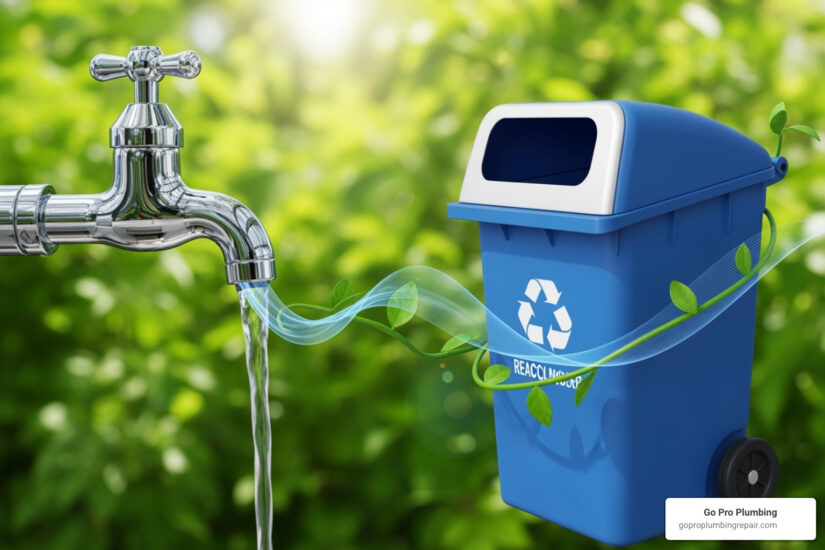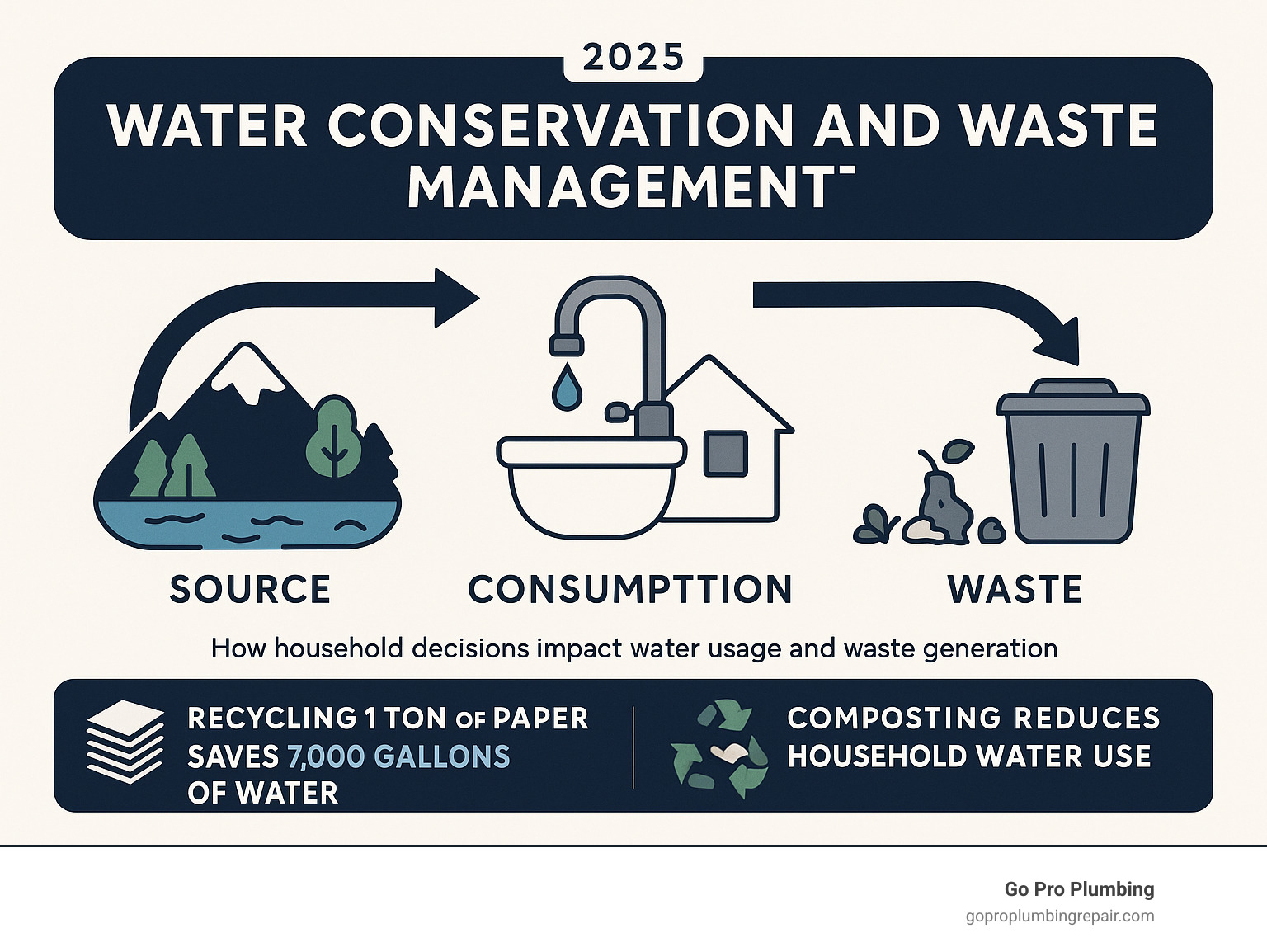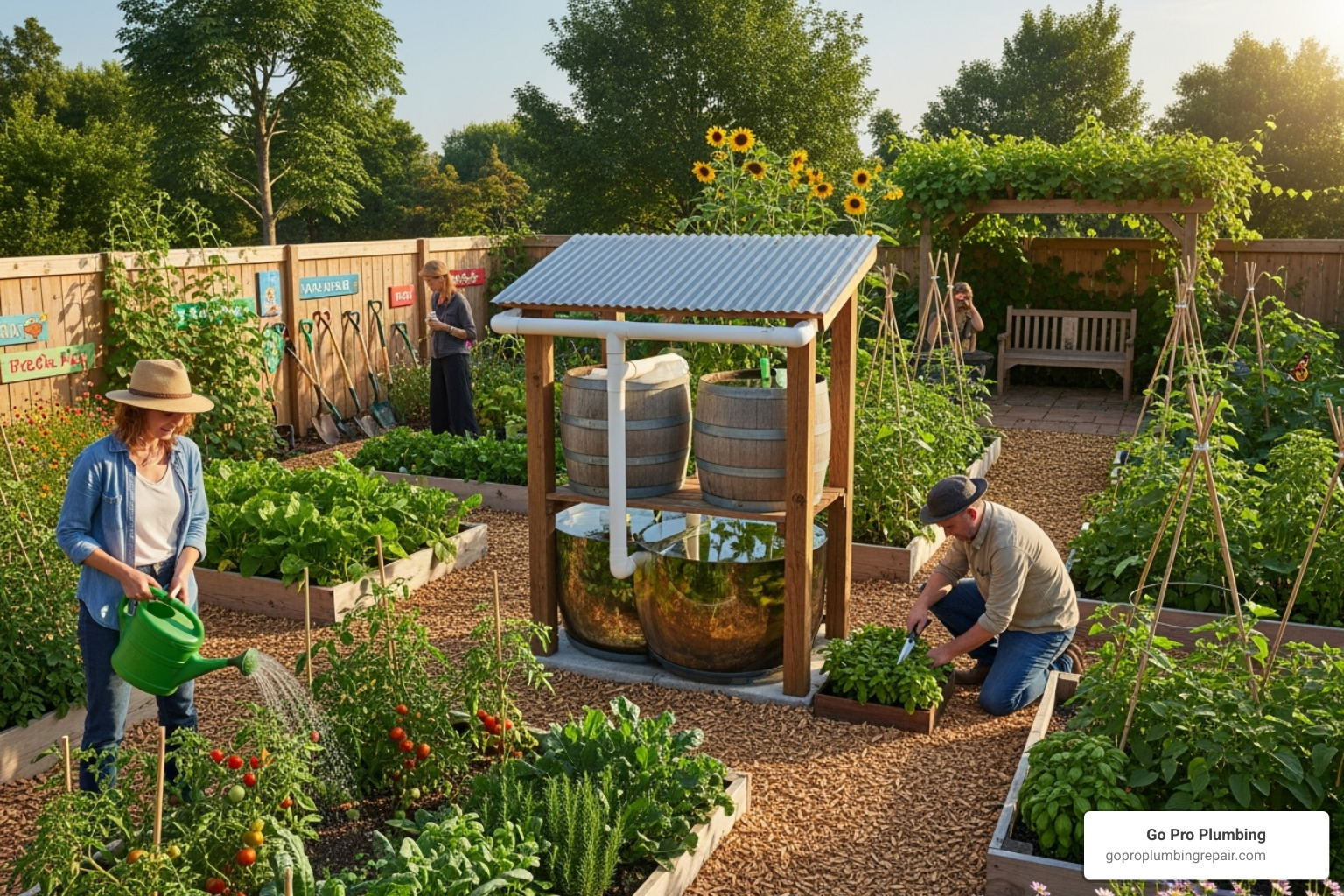Septic Systems to Sustainability: Integrating Water and Waste
By Brian on August 19, 2025

The Unseen Connection Between Your Faucet and Your Trash Can
Water conservation and waste management are deeply connected. Understanding this link can slash your utility bills and protect the environment.
Here’s how they work together:
- Manufacturing: Creating products uses massive amounts of water; recycling 1 ton of paper saves 7,000 gallons.
- Food Waste: Up to 40% of US food goes uneaten, wasting 21% of agricultural water.
- Energy: Water treatment and delivery require significant energy, so conservation saves both.
- Resource Cycle: Reducing waste means less manufacturing and less water consumption.
- Home Systems: Your plumbing and waste disposal directly impact local water resources.
The average American uses 140-170 gallons of water daily and contributes to a culture that wastes two-thirds of its resources. This cycle drives both water scarcity and environmental damage.
When you fix a dripping faucet or compost food scraps, you’re not just saving money. You’re part of a larger solution addressing climate change and resource depletion.
In drought-prone Northern California, this connection is critical. Every gallon saved and pound of waste diverted preserves precious groundwater and reduces the energy needed to transport water to your home.

Quick water conservation and waste management terms:
The Vicious Cycle: How Consumption Drives Water and Waste Crises
Our modern “buy-use-toss” lifestyle creates a relentless cycle that pressures our planet’s water resources. Every time we choose convenience over conservation, we feed a system that demands more water for manufacturing, more energy for processing, and more space for our waste.
In Northern California, we see this play out during drought seasons. When water is scarce, we confront an uncomfortable truth: nearly 90% of biodiversity loss and water stress is caused by resource extraction and processing. That new gadget, those fast-fashion clothes, and the packaging our food comes in all require massive amounts of water to produce.
The cycle is simple: increased consumption drives demand for raw materials, which requires more water. This depletes water sources, making droughts more severe. It’s like trying to fill a bucket with a hole in the bottom. But understanding this cycle gives us the power to break it.
Why Every Drop Counts: The Importance of Water Conservation
Only about 2% of Earth’s water is fresh, and just 1% is drinkable. Suddenly, a dripping faucet doesn’t seem so harmless.
Water conservation isn’t just about being responsible—it protects your wallet. The average family spends $1,100 per year on water, but you can save $350 annually just by upgrading to water-efficient fixtures and appliances.
Every gallon you save helps replenish our underground aquifers, which are crucial here in Northern California during dry spells. When you take shorter showers or fix leaks promptly, you’re making a deposit into this natural bank account.
The energy savings are also impressive. Electricity production accounts for nearly half of the nation’s freshwater withdrawals. Using less hot water reduces energy consumption and cuts your carbon footprint.
Our Domestic Water Conservation guide shows you how to tap into savings, and our Water Resources and Conservation resource explains the bigger picture.
The Hidden Cost of “Throwaway” Culture
For every bag of trash you put on the curb, 87 bags of waste were created upstream during manufacturing. This upstream impact represents all the water, energy, and raw materials used to create products before they reach you.
Manufacturing water use is staggering. Virgin pulp and paper mills are among the largest industrial users of fresh water. Every time you buy something made from new materials instead of recycled ones, you’re indirectly pulling water from stressed ecosystems.
The most shocking waste happens in our kitchens. Up to 40% of US food goes uneaten, meaning we’re throwing away 21% of all agricultural water use. Imagine filling five glasses of water and pouring one directly down the sink—that’s what we’re doing with our food system.
This isn’t just about wastefulness; it’s about understanding the material lifecycle. When you compost food scraps or choose products with minimal packaging, you help break the cycle that connects your trash can to water shortages. The solution is making smarter choices that benefit your budget and the planet.
Smart Water Savings: Practical Strategies for Indoors and Outdoors
When it comes to water conservation and waste management, your home is where the magic happens. Making smart water choices doesn’t mean sacrificing comfort, and we’ve seen how simple changes can make a huge difference. One customer saved over $400 on their annual water bill just by upgrading a few fixtures and habits.

Understanding where your water goes is the first step. A comprehensive Water Efficiency Audit can reveal surprising usage patterns.
Indoor Water Conservation: Your First Line of Defense
Your bathroom and kitchen are the front lines of water use. Small changes here create the biggest impact.
- Fix Leaks: This is your secret weapon. A dripping faucet can waste 170 gallons a day, and a leaky toilet can waste up to 200 gallons daily without you noticing. We handle everything from simple faucet repairs to complex Water Heater Leak Repair.
- Upgrade Toilets: Toilets are the biggest water users. Upgrading an old 3.5-7 gallon per flush model to a 1.28-gallon high-efficiency toilet saves thousands of gallons annually. Our Toilets service includes installing water-efficient models.
- Shorter Showers: Cutting a 15-minute shower to 8 minutes with a low-flow showerhead can save over 15,000 gallons per year.
- Choose Smart Fixtures: Look for WaterSense labeled products and ENERGY STAR® qualified appliances. A new ENERGY STAR washer uses 13 gallons per load instead of 23. We can help you choose and install efficient Faucets & Sinks.
- Run Full Loads Only: This rule applies to both dishwashers and washing machines. Modern dishwashers use less water than hand-washing when fully loaded.
- Get Hot Water Faster: Tankless Water Heaters eliminate the wait for hot water, which means less water down the drain.
Outdoor Water Conservation: Creating a Water-Wise Oasis
In Northern California, outdoor watering can account for 70% of your summer water bill. A water-wise landscape is about working with nature, not against it.

- Xeriscape: This approach uses drought-tolerant native plants that thrive in our climate with minimal water. Our Water Conservation Landscaping guide shows you how.
- Water Smart: Water early in the morning to reduce evaporation. Use the “step test” on your lawn—if it springs back, it doesn’t need water.
- Harvest Rainwater: A simple rain barrel can collect 600 gallons from just one inch of rain on a 1,000 sq. ft. roof. That’s free water for your plants!
- Use Efficient Methods: Soaker hoses and drip irrigation deliver water directly to the roots, eliminating runoff and evaporation.
- Mulch: A 3-inch layer of organic mulch reduces evaporation, suppresses weeds, and keeps soil moist longer.
- Clean Wisely: Use a broom instead of a hose to clean driveways. When washing your car, a bucket and sponge can save up to 150 gallons.
The Zero Waste Approach to Water Conservation and Waste Management
Think of your trash can as a hidden water bill. Every item you toss represents gallons of water used to create it. The zero waste mindset, which focuses on a circular economy where materials are reused, dramatically reduces the demand for water-intensive manufacturing.
Currently, the US buries or burns two-thirds of its waste daily, destroying valuable materials and forcing manufacturers to extract fresh resources. This strains our water systems and waste infrastructure, including services like our Sewer Line Service. Whether you’re composting or recycling, you’re conserving water upstream.
How Recycling Directly Saves Water
Here’s a fact that might surprise you: recycling 1 ton of paper saves 7,000 gallons of water. That’s enough for a family of four for nearly two months! When manufacturers use recycled paper instead of processing new pulp from trees, they slash their water consumption.
Aluminum recycling tells a similar story. It uses 95% less energy than creating new aluminum. Since energy production requires massive amounts of water, this translates directly into water savings. Plus, recycling one ton of aluminum eliminates 2.7 tons of mining waste, a process that also requires enormous amounts of water.
Every recycled item means less resource extraction, manufacturing, and water consumption. You can even calculate your impact with the EPA’s WARM tool. Of course, proper waste management starts with systems that work, and regular Drain Cleaning ensures everything flows smoothly.
The Power of Composting for Water Retention
Food waste is a prime example of hidden water waste. When we throw away food, we also waste all the water that grew it. With up to 40% of US food going uneaten, we’re essentially throwing away 21% of all agricultural water use.
Composting is a water conservation superhero. It transforms kitchen scraps into “black gold” that acts like a sponge in your garden. Compost-amended soil can hold significantly more water, reducing your irrigation needs. It’s like giving your garden a built-in water storage system.
Healthier soil also creates more drought-resistant plants that need less water to thrive. Composting closes the loop: the water that grew your vegetables continues working in your garden soil. For businesses, our Commercial Drain Cleaning services can support effective composting programs by ensuring systems run smoothly.
Building a Sustainable Future: Community and Individual Action Plans
Real change happens when individual actions meet community momentum. Imagine the impact when your entire neighborhood accepts water conservation and waste management together.

Community education is powerful. When homeowners understand the connection between their habits and water scarcity, they become champions for change. Technology like smart water meters helps, allowing you to track usage in real-time and spot leaks early—a feature we love because it saves our customers money.
Your Personal Water and Waste Action Plan
Creating your own plan is about paying attention and making small adjustments.
- Monitor Your Water Meter: Check it regularly to spot unusual spikes that might signal a hidden leak. Many utilities offer online portals for easy tracking.
- Conduct a Home Water Audit: Walk through your property looking for dripping faucets, running toilets, or sprinklers watering the sidewalk. Our Water Saving Program can help you turn these findings into action.
- Practice Conscious Purchasing: Nearly 90% of water stress comes from resource extraction and processing. Choose durable items over disposable ones and support brands using recycled materials.
- Adopt Simple Habits: Turn off the tap while brushing teeth, take shorter showers, run full loads, scrape plates instead of rinsing, compost food scraps, and recycle everything possible.
Community-Wide Solutions and Getting Involved
Your efforts are magnified when they’re part of a larger community movement.
- Know Local Restrictions: In Northern California, water restrictions are our collective strategy for protecting shared resources during droughts.
- Use Rebate Programs: Many local water agencies offer rebates for installing low-flow toilets, efficient washers, and smart irrigation systems, often cutting upgrade costs in half.
- Support Public Outreach: Share information from programs like Save Our Water with neighbors. When schools teach water education, they create the next generation of water-conscious citizens.
- Advocate for Policy: Support common-sense regulations like water efficiency standards and investments in infrastructure. For businesses, Industrial Water Conservation offers ways to reduce their water footprint, benefiting the entire community.
Frequently Asked Questions about Water Conservation and Waste Management
We hear the same questions about water conservation and waste management from homeowners across Northern California. Here are the answers to the most common ones.
How much water can I really save by fixing a small leak?
A surprising amount. A single faucet dripping slowly can waste over 170 gallons of water every day—that’s more than 5,000 gallons a month. Leaky toilets are even worse and often silent, wasting thousands of gallons. Since toilets account for 28% of home water use, a leak has a huge impact. Regular plumbing checks are crucial. If your water bill is creeping up, call for Emergency Plumbing Leak Repair to stop the waste fast.
Does it take more water to wash dishes by hand or use a dishwasher?
For most families, the dishwasher wins. Modern, ENERGY STAR certified dishwashers are highly efficient and use far less water than handwashing, especially if you let the tap run. To maximize efficiency, follow two simple rules: scrape food off plates (don’t pre-rinse) and only run the machine when it’s completely full. A half-empty dishwasher uses nearly the same amount of water as a full one.
What is the single most effective thing I can do to reduce my water footprint through waste management?
While recycling is important, the most powerful action you can take is reducing food waste. Up to 40% of food in the US goes uneaten, which means we’re also wasting the 21% of all agricultural water used to grow it. When you throw away food, you’re throwing away all the water it took to get it to your plate. By planning meals, storing food properly, and buying only what you need, you make a direct and massive impact on water conservation. Composting any unavoidable scraps is the next best step.
Conclusion: Integrating Your Habits for a Healthier Planet
We’ve uncovered the powerful link between water conservation and waste management. From the 40% of food that goes uneaten to the 170 gallons a day a small leak can waste, these connections are everywhere.
Understanding this water-waste-energy nexus transforms simple daily actions into meaningful impact. When you turn off the tap, you also save the energy needed to treat and pump that water. When you compost, you create soil that holds moisture, reducing future watering needs.
These habits have long-term benefits. Your household can save hundreds of dollars annually, your garden becomes more drought-resistant, and our community’s groundwater gets a chance to recharge. Our consumption choices directly affect the planet’s health, as nearly 90% of water stress comes from resource extraction. By choosing to repair, recycle, and conserve, we vote for a more sustainable future.
At Go Pro Plumbing, we are your partners in this mission. We’re here to help you create a water-efficient home that benefits your budget and the environment. Our same-day service means you can start saving water immediately.
Whether you have a sneaky leak, are considering low-flow fixtures, or planning a full renovation, we have the expertise to help. For professional help with all your home’s water-saving needs, explore our Water Conservation services.
Every drop counts. Together, we can make sure none go to waste.
